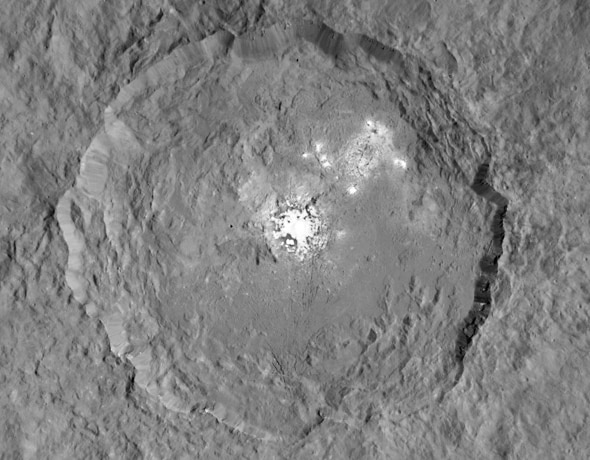Create a free profile to get unlimited access to exclusive videos, sweepstakes, and more!
Bright Spots on Ceres Are Coming Into Focus

The image above is the newest view of the 92-kilometer-wide Occator crater on Ceres—the one with the bright spots in it. This shot, taken when the Dawn spacecraft was only 1,500 kilometers (915 miles) above the surface of Ceres, shows far more detail than we’ve seen before. It’s actually a composite: Two images combined, one that exposes the bright spots well, and another that shows the darker material in the crater around it exposed correctly.
Many of the bright spots are now resolved, and are clearly localized to specific places. The central region of the crater is not just a blob, but has some places where the coverage with the brighter stuff is full, and others where it’s spottier. In the upper right, many spots are obvious, as well as a fainter covering of brighter material on the surface.
There’s more new stuff to see, too: Linear dark markings that look very much like cracks in the surface are now visible. There are a few in that patch of brighter material in the upper right that are hard to resolve, and another series (Ceres?) of them that appear to follow the topography at the bottom of the photo near the crater rim. The ones at the bottom are obviously cracks; perhaps created as material in the crater floor subsided. It almost looks like something flowed there, hardened, and shrank to cause the cracks.
I’m speculating, of course. We still don’t know exactly what these bright spots are, but the cracks may be a clue. We know there’s lots of water ice inside Ceres, and these spots might be ice that has been squeezed out. The water may in fact be salty; if the ice on the surface sublimated (turned into a gas) due to sunlight hitting it, then the salt would be a residue, like getting salt crystals on you when seawater evaporates after you swim in the ocean.
I’ll note the crater rim shows very obvious evidence of collapse; the walls are quite steep, and there’s lots of material piled up inside the crater. If you look carefully you’ll see brighter spots along the rim wall, though those may just be somewhat fresher material (and not necessarily ice or salt).
Images like this are truly wonderful. We’re getting a close-up look at a protoplanet! As I wrote in an earlier post, Ceres is usually thought of as the largest of the asteroids, but a team member on Dawn told me they think of it more as a protoplanet: An object that got large enough that it started taking on the properties of a planet. Asteroids, on the other hand, are essentially leftover rubble, the building blocks of planets that have undergone a lot of impacting and shattering.
I still haven’t heard anything about the mineralogy of the surface; hopefully the detectors on Dawn will be able to distinguish between clean water ice and salt with enough resolution to tell us what these spots are. We’re still awaiting the scientific analysis of all the data. Certainly the spots are eye-catching, but more than that they’re an important clue to the surface, interior, and history of Ceres.
What are they? Maybe we’ll know soon.


























